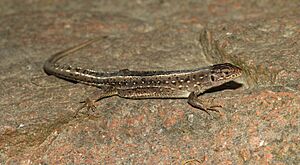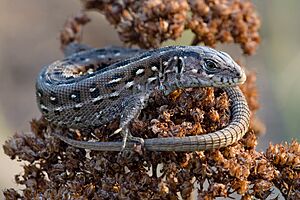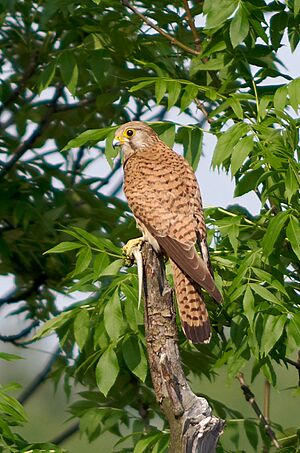Sand lizard facts for kids
Quick facts for kids Sand lizard |
|
|---|---|
 |
|
| Male | |
 |
|
| Female | |
| Conservation status | |
| Scientific classification | |
| Genus: |
Lacerta
|
| Species: |
agilis
|
 |
|
| Range of L. agilis Extant, resident | |

The sand lizard (Lacerta agilis) is a type of lizard found in many parts of Europe. You can find them from France all the way to Lake Baikal in Russia. They are not found in European Turkey. Their homes are often spread out in small areas. In colder places like southern England, sand lizards need warm, sunny places like seaside heathlands. The sun's warmth helps them keep their eggs warm, which they lay in sand.
Male sand lizards are known for their bright colors. They can be quite competitive during mating season. Unlike some other lizards, their mating season is very short. Males are often more particular about choosing a mate than females. Females usually lay only one group of eggs each year.
Sand lizards spend most of their time warming up in the sun, looking for food, or hiding under plants. They like to live in different kinds of places. Male lizards have large home areas that often overlap with other males. They might compete with each other. Female lizards have smaller areas that are often next to each other. Sometimes, females even share their homes. Sand lizards can live for up to ten years.
Contents
What Does a Sand Lizard Look Like?
Sand lizards look different depending on if they are male or female. This is called being sexually dimorphic. In northwest Europe, both male and female sand lizards have stripes on their sides and backs. These stripes have eye-shaped markings, which are dark spots with light centers. Their colors can change across Europe and Russia.
Males have thinner markings than females. During the spring mating season, the sides of the males turn bright green. This green color fades away in late summer. Adult males can grow up to 19.3 centimeters long. Adult females can reach about 18.5 centimeters.
There are several types, or subspecies, of sand lizards. The one found furthest west is called L. a. agilis. In this type and another western type (L. a. argus), the stripe on their back is thin or sometimes missing. The L. a. argus can even have a plain red or brown back with no markings. In these two types, only the sides of the males turn green. But in eastern types (like L. a. exigua), males can be completely green, even when it's not mating season.
Most sand lizards live in Eastern Europe. They are very common in countries like Poland and the Czech Republic. They warm themselves on rocks during the day. At night, they go into holes underground. To protect themselves, they can drop their tails and bite enemies.
Male sand lizards get very green during mating season. The brighter their green color, the stronger they often are. Males with brighter colors are more likely to start fights and win them. This usually means they have more success finding mates. Sand lizards can live for over ten years, but most live about 5 to 6 years.
Where Do Sand Lizards Live?
Sand lizards can be found in many different places. They like dry areas such as rocky spots, fields, hills, beaches, heathland, sand dunes, and rock gardens. In warmer parts of Europe, they live in many types of habitats. But in colder places like Great Britain, they need sand to keep their eggs warm. This means they mostly live near the coast there.
Male sand lizards have large home areas that often overlap a lot. Female sand lizards have much smaller home areas, usually less than 100 square meters. Their areas are often next to each other, and they might even share burrows or sunny spots. They prefer places with many different plants and structures. This creates different warm and cool spots they can move between as needed.
Sand Lizard Behavior
Daily Activities
After waking up, sand lizards spend a lot of time warming themselves in the sun. They sometimes take breaks to look for food. They also spend time under hidden plants. If the weather is bad, sand lizards come out later and spend less time in the sun.
Sand lizards most often warm themselves on logs. Logs hold heat well and release it slowly. They also give the lizard a good view to spot danger or food. They rarely share sunny spots with other lizards. Male sand lizards especially avoid sharing sunny spots with other males. They only sometimes share with females. They prefer to warm up on plants rather than open sand or soil. They control their body temperature by moving between sunny and shady areas.
Choosing a Mate
In many animals, females are more careful about choosing a mate than males. This is because females usually put more time and energy into raising their young.
Female sand lizards will usually refuse males who try to mate outside of their ready period. They do this by a special head-bobbing movement. However, when they are ready to mate, females do not seem to pick and choose between different males.
Male sand lizards often prefer larger females when choosing a mate. But they will still mate with smaller females if they get the chance.
Sand Lizard Life Cycle
Reproduction
Males usually become ready to mate when they are smaller than females. Females start producing eggs about 45 days after waking up from hibernation. Both males and females lose body fat during mating season. This is because they use their stored energy from fat and their liver. After a few weeks of being awake, male adults become very competitive. They try to mate with as many females as they can.
Female sand lizards lay their eggs in loose sand in a sunny spot. The warmth from the ground helps the eggs hatch.
Female sand lizards usually lay only one group of eggs each year. Each group can have between six and 15 eggs. The time of year when females lay their eggs can vary a lot. But generally, a female sand lizard lays her eggs around the same time each year. Larger, healthier females often lay their eggs earlier. These early eggs often produce larger, more successful young that are more likely to survive.
When female sand lizards lay more eggs, each individual baby lizard tends to be smaller. If they lay fewer eggs, the babies are larger. If there is a lot of food, females lay more eggs. This suggests that sand lizards change the number and size of their eggs based on how much food is available. The space available to lay their eggs also plays a role.
Reproductive Success with Age
Studies show that as sand lizards get older, they have more success reproducing. This is likely because they grow larger as they get older, not just because they have more experience. Larger female sand lizards can simply produce more eggs because they have more space inside their bodies.
Avoiding Inbreeding
Sometimes, sand lizards are born with problems. This is often because of inbreeding, which happens when closely related lizards mate. Because sand lizards can live for a long time, and males often mate with many females, inbreeding can happen. Studies in labs have shown that inbreeding can cause the same problems seen in wild sand lizards.
Who Are Their Enemies?

Many animals hunt sand lizards. These include weasels, foxes, badgers, birds of prey, and snakes. Even pets like pheasants, chickens, and cats can hunt them.
How fast and agile a sand lizard is helps it escape from enemies and find food. Like many lizards, sand lizards can drop their tail if a predator grabs it. This helps them get away. Lizards that have dropped their tails can run faster and are better at escaping. Their tails do not grow back to their full original length.
Sand lizards often carry ticks. Ticks can be very bad for the lizards' health, especially for males during mating season when they move around a lot. Males with larger home areas tend to have more parasites. Many types of parasites, like trematodes and nematodes, can live inside these lizards.
Fighting and Competition
Male sand lizards often mate with many females. They compete with other males in very aggressive ways. Mating lasts about 2 to 4 minutes. After mating, the male will guard the female for hours or even several days to protect her. After this, he will look for new mates.
When male sand lizards compete for females, they perform special displays. These often turn into aggressive behaviors and even real fights. Males stand up on all four legs and turn sideways to try and scare their opponents. One male might back down. If not, they will start fighting. They mainly bite each other, aiming for the head or other weak spots. Sometimes, they can cause very deep cuts. Males of similar size usually have longer fights. However, males fighting intruders in their own areas do not win more often than the intruders.
If male sand lizards fight each other multiple times, they will remember each other as rivals. However, later fights between rivals are usually much shorter than the first one. This is probably because they recognize each other. They can guess the outcome of the fight, so they end it quickly.
The sand lizard mating season is very short, lasting only about 17 days a year. Males can mate with a maximum of six different females during this time. Guarding a single female can take up to 18% of the entire mating season.
Because guarding a female takes several days, male sand lizards put a lot of effort into mating. This means males can start to choose certain females. Female sand lizards are often found close together in groups. This gives males more choices to pick a mate based on what they like.
Protecting Sand Lizards
This lizard is considered threatened and is strictly protected by law in the UK and most of Europe. This is different from the L. a. exigua type, which is called the "common lizard" in Russia.
In the UK, the Amphibian and Reptile Conservation Trust helps protect sand lizards. They have a successful program where they raise lizards in captivity and then release them into the wild.
Sand lizards face many dangers, including their homes being destroyed or damaged. Their habitats are also becoming broken up into smaller pieces. Not managing their habitats properly also hurts them. Even though sand lizards are protected in the UK, more needs to be done. This includes protecting their homes, managing their habitats, protecting the species itself, studying where they live, checking their numbers, doing scientific research, and making people aware of their situation.
Efforts have been made in the UK to protect and save their homes. This is because the sand lizard is one of only six reptile species found in Britain. Scientists have studied lizard populations and their homes. They have made specific suggestions for keeping these areas healthy so sand lizards can continue to live there.
Images for kids
-
A sand lizard in Penza Oblast, Russia
See Also
- Hesketh Golf Links, a special protected area in the UK where sand lizards live
- List of reptiles of Great Britain
- List of reptiles of Italy








